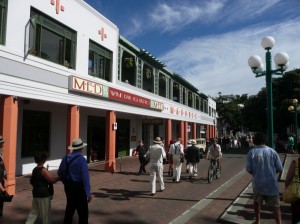The Art Deco Trust in Napier, has recently celebrated its 21st annual Art Deco Weekend, which has grown every year since its inception in the 80s. I was lucky enough to have attended the latest one, with several thousand attendees – a far cry from the very first Art Deco Weekend that I helped organise, where we managed to amass about a hundred or so enthusiastic people. At the first weekend, we had a total of 4 events, and it all took place over a day and a half; whereas now it has hundreds of events and takes all week. I had to organise the vintage 1930s car parade, which fortunately was one of the easier events I’ve ever had to organise: I just rang up the local Ford club, and they said they would be happy to come and how many cars would we like to arrive (we settled for around 10 cars, from memory).
Now the car parade has grown to such a massive scale that it is having to be limited in numbers to just a few hundred so that the audience don’t get exhausted. The cars are superb: nearly all are from the 1930s era suitable to the earthquake and the rebuilt city, and apparently the Napier run is now a central part of car enthusiasts annual calendar.
The architecture is the thing that remains the same – in fact, it has improved over time, with careful nurturing and painting of the city’s stock, Napier now really truly can take the title of The Art Deco Capital of the World. But what has surprised me the most is the attitude of the attendees, especially towards the dressing up in 30s costume. In that first weekend, there wasn’t a single person that dressed up as in ‘Deco-style’ clothing, whereas in the latest weekend, 21 years on, there was almost not a single person who didn’t dress up.
It is a fantastic and slightly disturbing facet to the weekend that I couldn’t quite get my head around – disturbing because it all just seems so much better when people do dress up. It is quite a bizarre thing to see (in 2009) a crowd of 5000 all dressed in clothes circa 1930, and all looking so much better as a result. The crowds of chaps in blazers and boaters, ladies in floaty flapper numbers and strings of pearls and demure / jaunty hats, and even tiny children in braces and flat caps: it all just goes so well with the cars, the events, and of course: the architecture.
But for me, it is the architecture that really takes the cake – so I just donned my boater and looked anew at the sparkly pastel facades. Napier, and its twin sister city Hastings, have been blessed with some of the world’s finest Art Deco and Spanish Mission style architecture, styles which go so well with the strong hot sunlight and deep blue skies of Hawkes Bay.
The townspeople had mostly got bored with the Art Deco in the 1980s, and really couldn’t care less if it was all torn down: apart from 3 buildings lost in the 80s (the National Bank, the ANZ bank, and the UFS pharmacy in Napier, and a larger handful in Hastings), the cities are still standing much as they were in the years following the 1931 earthquake. The Art Deco Trust is solely to thank for that, with primarily, the efforts of Mary Johnstone and Robert McGregor to thank for over 2 decades of extremely hard work, along with hundreds of inexhaustable volunteers. Luckily, the population now seem to broadly agree that its all quite splendid, and that they do like the Art Deco buildings after all. Long may that continue.
g-m







Leave a Reply